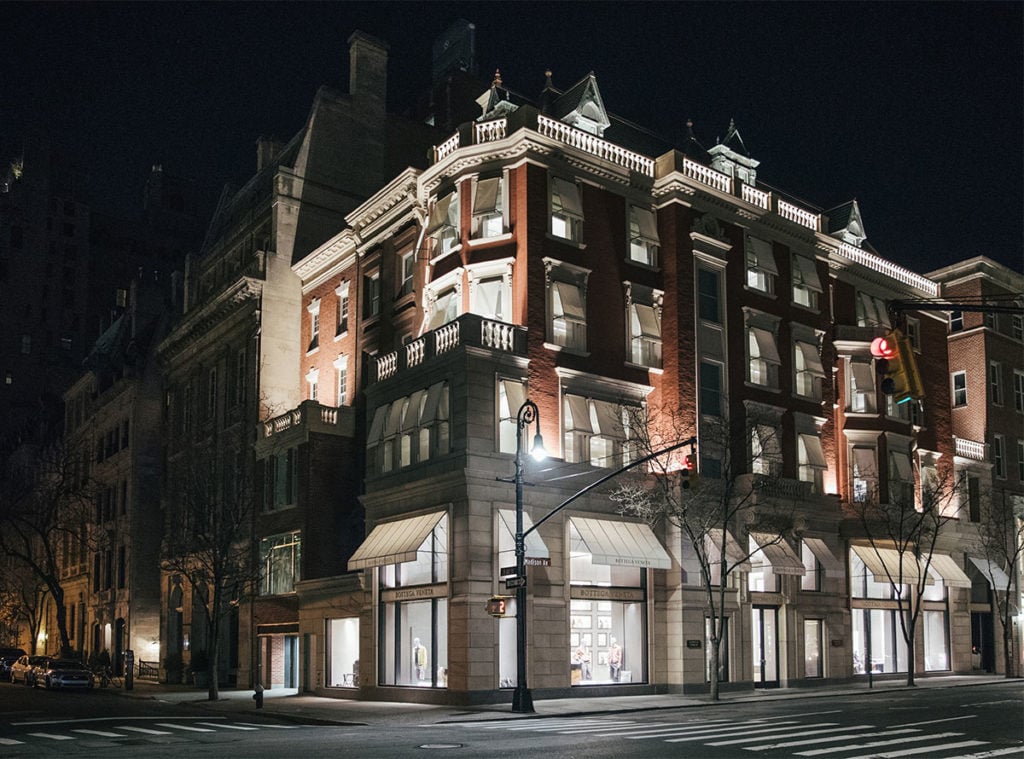In February, Bottega Veneta creative director Tomas Maier unveiled something of a pièce de resistance: the Italian lifestyle brand’s New York maison, which, combining three landmarked townhouses on Madison Avenue for a total of close to 15,000 square feet, is its largest store in the world. The masterstroke is the Apartment, the boutique’s top floor, devoted to the brand’s home collection and styled as a light, airy living space filled with custom Bottega Veneta furniture and a selection of art personally curated by Maier.
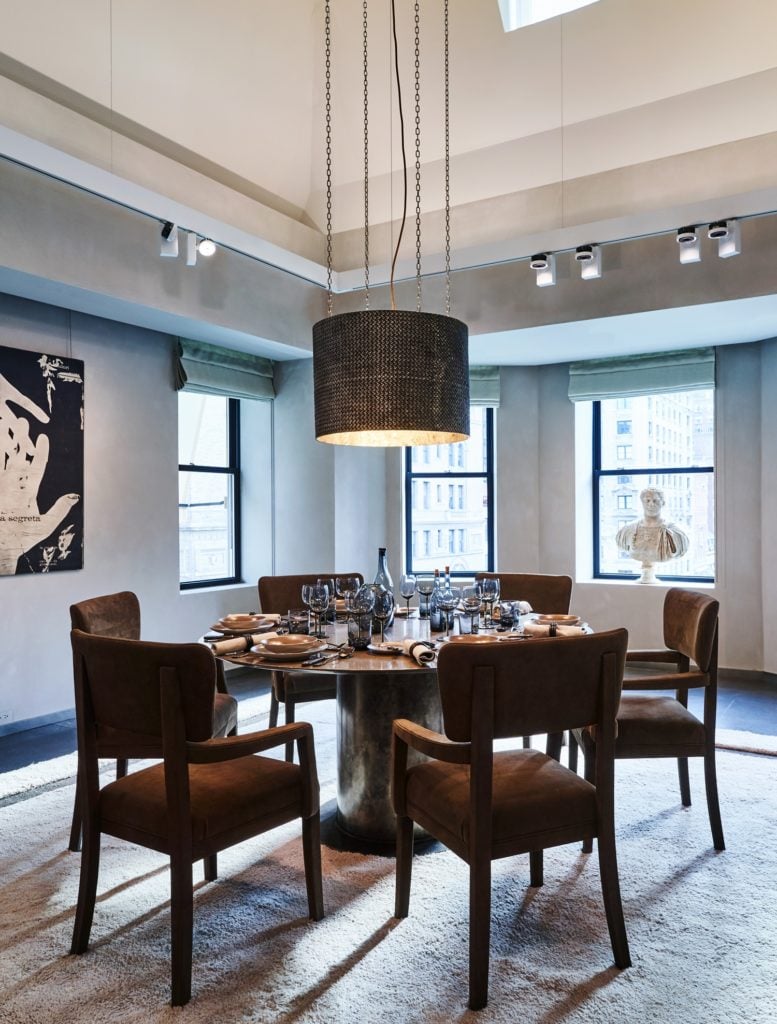
Bottega Veneta’s Maison in New York City. Photo: Adrian Gaut, courtesy of Bottega Veneta.
With its beautifully laid table (the plates are a collaboration with porcelain maker KPM Berlin; the glassware is Murano) and suspiciously clutter-free desk, the place feels like the serene pied-à-terre of an art-savvy friend. It’s a prime example of the way Maier has made fine art an integral part of the Bottega Veneta world. As traditional retailers scramble to retake market share from e-commerce sites by offering real-life “experiences” that digital sellers can’t, Maier is ahead of the game, providing his clients a dose of culture while they browse the label’s tastefully arrayed goods.
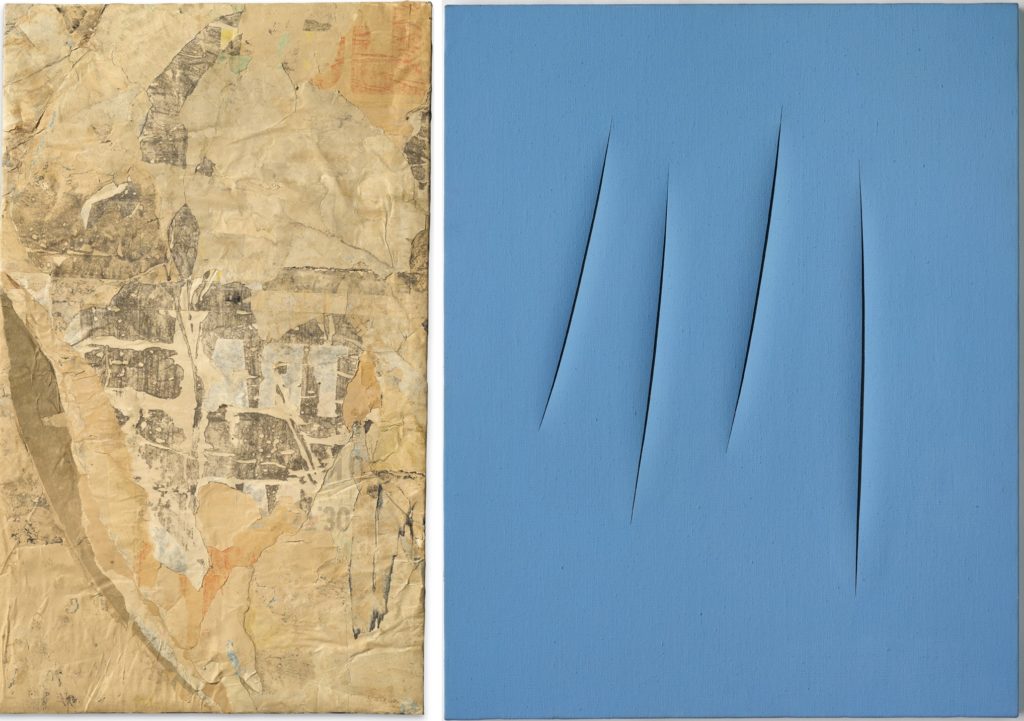
Left: Mimmo Rotella’s A Mezza Luna (1960); Right: Lucio Fontana’s Concetto spaziale, Attese (1967). Images courtesy of Robilant+Voena.
“For the artwork, I partnered with a European gallery called Robilant+Voena, with whom I’ve worked for several years on our presentations for Salone del Mobile,” Maier told artnet News. “The maison is very cosmopolitan and reflects New York City, but everything in it is made in Italy, so I chose all Italian artists, including Mimmo Rotella, Mario Schifano, Ettore Spalletti, and Lucio Fontana, with works mostly from the 1960s and ’70s. That period was very experimental and forward-thinking, but I think it’s not as well known in the US.”
A Mezza Luna, an ocher-colored 1960 décollage piece by Rotella, hangs above Bottega Veneta’s Meta armchair in brown suede, while across the room Agostino Bonalumi’s monochrome, horizontally ridged Bianco (1979) is paired with an impeccable gray Rudi couch. The art isn’t only there to complete the dream-apartment fantasy, however—it’s for sale, too, through the gallery. Fontana’s Concetto spaziale, Attese (1967), a slashed canvas in steel blue, has already sold. There’s a blank wall where it used to hang, but not for long. Maier plans to rotate the works, refreshing his mini exhibition as pieces are purchased or the Apartment is redecorated.
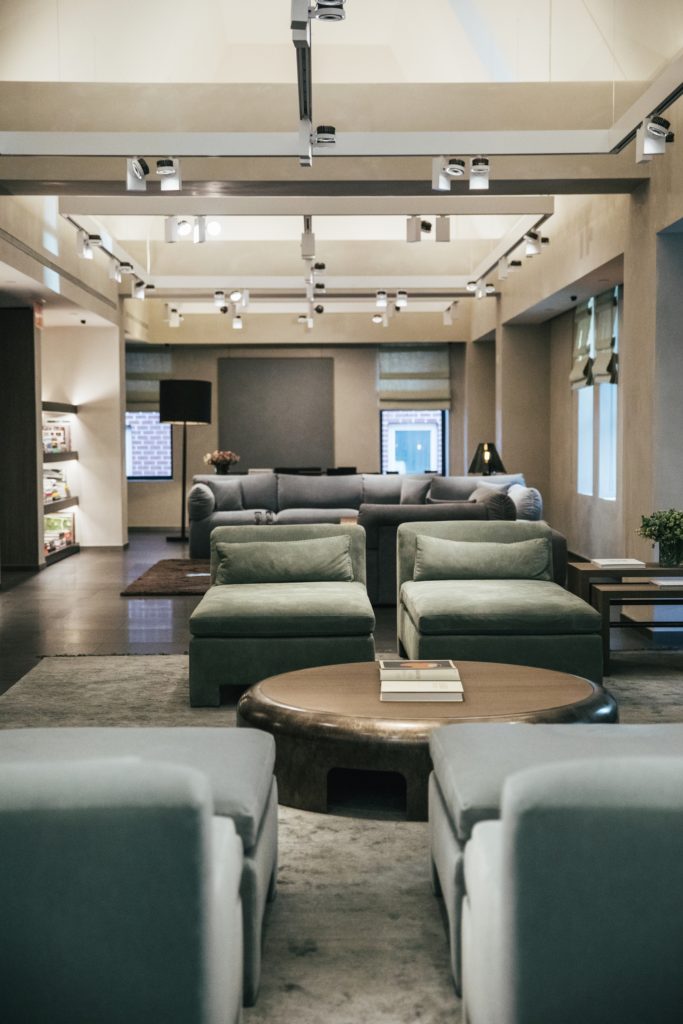
Bottega Veneta’s Maison in New York City. Photo: Adrian Gaut, courtesy of Bottega Veneta.
The books that populate the shelves and side tables offer another intriguing window into Maier’s aesthetic tastes. The 130-some titles, hand-selected by Maier (and also for sale), include little gems like Edith Bouvier Beale of Grey Gardens amid monographs on Marilyn Minter, Gerhard Richter, and Louis Kahn.
Maier’s passion for art and architecture is no secret. Though he’s made his reputation as a fashion designer—in addition to overseeing Bottega Veneta ready-to-wear and accessories, he has an eponymous label and debuted a summer-themed collection with Uniqlo last month—he’s often collaborated with visual artists and has had a hand in designing several of Bottega Veneta’s high-profile stores.
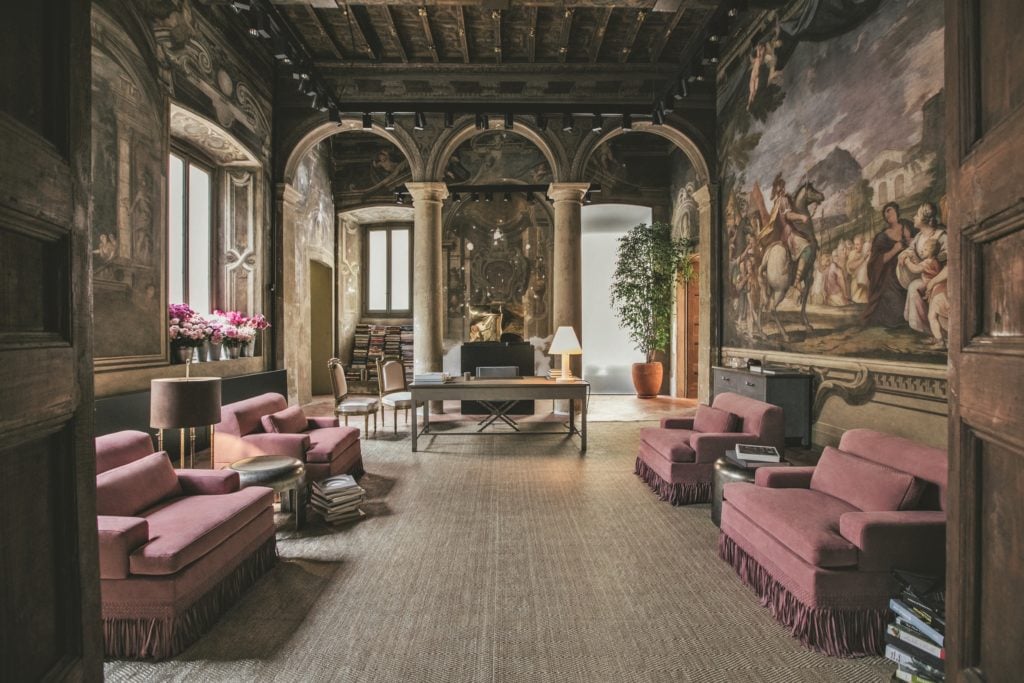
Interior of Bottega Veneta in the Palazzo Gallarati Scotti. Courtesy of Bottega Veneta.
Two years ago, the company opened a dedicated boutique for its home collection, conceived and designed by Maier and located on the ground floor of the Palazzo Gallarati Scotti, an 18th-century residence on Milan’s Via Borgospesso with coffered ceilings and frescoes by Rococo painters Giovanni Battista Tiepolo and Carlo Innocenzo Carloni. The paintings—dazzling neoclassical scenes rife with putti, Roman soldiers and trompe l’oeil architectural features—form an unexpected backdrop for a line of coolly sophisticated furnishings. The contrast works, highlighting the strength of the collection, which holds its own in a roomful of museum-worthy art.
For the launch of the 2018 collection during Milan’s Salone del Mobile in April, Maier accented the space with modern sculptures by Bonalumi and Pietro Cascella and works by Rotella and Alberto Burri, again from Robilant+Voena, to complement the line’s newest pieces: sleek couches and sectionals upholstered in expertly worked leather (produced with venerable furniture maker Poltrona Frau), featuring details like fringed trim and the brand’s signature intrecciato pattern.
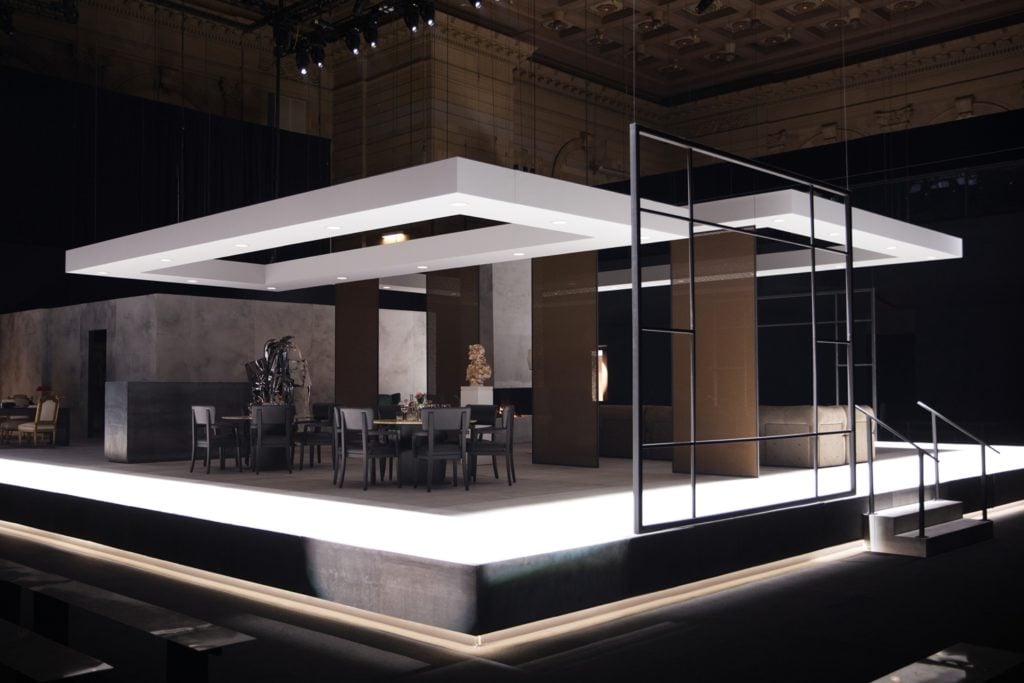
Bottega Veneta’s NY Fashion Week set. Image courtesy of Bottega Veneta.
Major works even made their way onto Bottega Veneta’s fall/winter 2018 runway. For Fashion month last February, the label, which usually shows in Milan, shifted its presentation to New York to coordinate with the opening of the new Madison Avenue store. The set, whipped up inside the American Stock Exchange Building, was designed—not incidentally—to look like a casually luxe apartment. It included a working fireplace; John Chamberlain’s chrome-plated steel sculpture Acediddley (2008), on loan from Gagosian; and Barry X Ball’s Envy (2008–2013), an Italianate bust from Sperone Westwater.
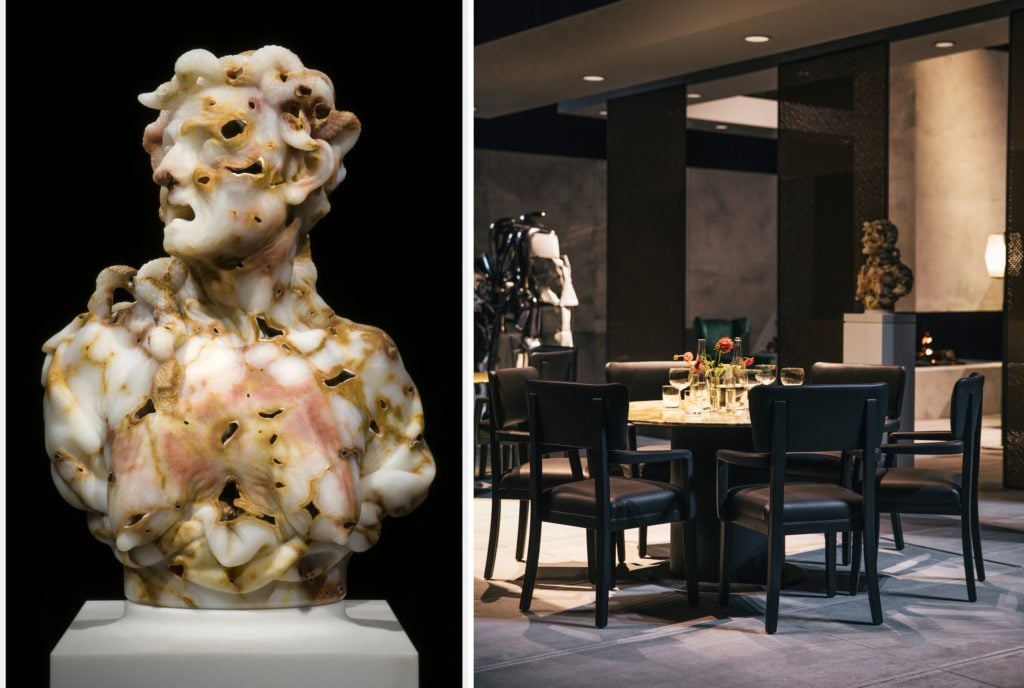
Left: Barry X Ball’s Envy (2013–2018), courtesy of Sperone Westwater; Right: Bottega Veneta’s NY Fashion Week set. Image courtesy of Bottega Veneta.
Naturally, the loans are equally beneficial to the galleries, granting their artists a wider audience and positioning the artworks as must-haves in any chic, tastemaking home. “It was exciting to be part of Bottega Veneta’s first runway show in New York,” Angela Westwater told artnet News. “I worked closely with [Broadway veteran] Scott Pask, who designed the amazing set and selected the important furniture and objects that created a contemporary New York apartment in keeping with the elegant vision of Tomas Maier. The choice of Envy was particularly brilliant and appropriate since it was inspired by La Invidia, circa 1670, by Giusto Le Court, in the collection of the Ca’ Rezzonico—the quintessence of the Venetian settecento.”
Robilant+Voena has partnered with Bottega Veneta since 2014. Co-owner Marco Voena is particularly pleased with the response to the gallery’s pieces at the Apartment in New York. Beyond making a sale, he’s expanded his customer base. “America is nowadays the center of Modern and contemporary art, and this relationship has proved to be very positive in terms of interest from many new American collectors whom we didn’t know before,” Voena told artnet News. Next season, he hopes to introduce works by other Italian artists underexposed in the U.S., such as postwar sculptor Pietro Consagra.
Such fresh opportunities for discovery are exactly what Maier is after. As the designer said, “I like to show my clients things they might not have seen.”
